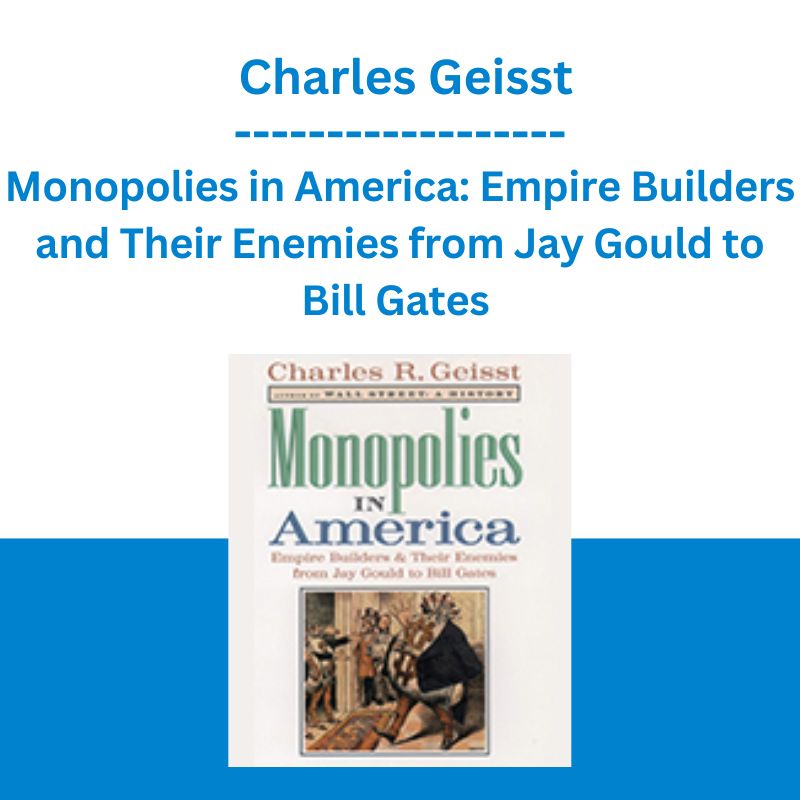*** Proof of Product ***
Exploring the Essential Features of “Monopolies in America: Empire Builders and Their Enemies from Jay Gould to Bill Gates – Charles Geisst”
In this incisive and comprehensive history, business historian Charles Geisst traces the rise of monopolies from the railroad era to today’s computer software empires.
The history of monopolies has been dominated by strong and charismatic personalities. Geisst tells the stories behind the individuals–from John D. Rockefeller and Andrew Carnegie to Harold Geneen and Bill Gates–who forged these business empires with genius, luck, and an often ruthless disregard for fair competition. He also analyzes the viewpoints of their equally colorful critics, from Louis Brandeis to Ralph Nader. These figures enliven the narrative, offering insight into how large businesses accumulate power. Viewed as either godsends or pariahs, monopolies have sparked endless debate and often conflicting responses from Washington. Monopolies in America surveys the important pieces of legislation and judicial rulings that have emerged since the post-Civil War era, and proposes that American antitrust activity has had less to do with hard economics than with political opinion. What was considered a monopoly in 1911 when Standard Oil and American Tobacco were broken up was not applied again when the Supreme Court refused to dismantle U.S. Steel in 1919. Charting the growth of big business in the United States, Geisst reaches the startling conclusion that the mega-mergers that have dominated Wall Street headlines for the past fifteen years are not simply a trend, but a natural consequence of American capitalism.
Intelligent and informative, Monopolies in America skillfully chronicles the course of American big business, and allows us to see how the debate on monopolies will be shaped in the twentieth-first century.
Editorial Reviews
From Library Journal
Geisst (Wall Street: A History) points out that for many people the board game remains their only exposure to the legal concept of monopoly. But buying up property and eliminating competitors is only part of the picture, according to this intriguing new book. Even though the origins of monopolies can be traced back to Elizabethan England, the model as we know it is uniquely American and has been with the United States since the mid-19th century. The first monopoly, which involved railroads, arose in part out of the economic needs of an expanding new country. Commodore Vanderbilt and Jay Gould certainly personify the monopolistic tendencies of the early railroads, but the greatest and arguably most infamous monopolist of the last 100 years was John D. Rockefeller Sr. Geisst states that “Monopolies were difficult to argue against when they provided a superior product. But when they could be shown to pose a threat to society at large, public sentiment shifted against them.” While Geisst knows his facts, he seems too careful in laying out the cast of characters while allowing his scholarly fairness to play down the genuine evils of certain monopolies. At times, he loses his historical narrative while giving attention to legal issues. Nevertheless, his book is recommended for larger nonfiction collections and all business collections.ARichard S. Drezen, Washington Post News Research Ctr., Washington, DC
Copyright 1999 Reed Business Information, Inc.
From Kirkus Reviews
Geisst (Wall Street, 1997) does his best to make the history of American monopoliesa topic more complex than Parker Brothers ever imaginedaccessible to the general reader. Skating gracefully through a Hit Parade of Monopolies, Geisst takes a mildly Manichaean view of his subject. In his remarkably even-handed introductory course, the regulators are no more heroic than the monopolists. The operations of Standard Oil, the railroad combines, the giant mineral and power trusts, and the money monopolies are briefly described, and the personalities and practices of Jay Gould and Morgan the Elder, Henry Kaiser and Harold Geneen quickly sketched. (Note that none of them drew a “go to jail” card; punishment, if any, was meted out to their corporations.) Aligned against the big businesses are the likes of Louis Brandeis, Upton Sinclair, and, latterly, Ralph Nader. Many of yesteryear’s villainously wealthy are recognizable from editorial cartoons of the day; certainly the caricatures wielded no small influence in the sporadic antitrust campaigns by various administrations. Sometimes strong, often weak, the impact of legislation like the Sherman, the Clayton, and the Robinson-Patman Acts depended less on predatory activity than on the political climate. Not so long ago, AT&T was dismantled. Now the components are being reassembled in new horizontal monopolies. Still on the books, Glass-Steagall, the Depression-era restriction against amalgamations of financial businesses, is simply ignored today as banks, brokers, and insurers combine and recombine with a resourcefulness DNA might envy. Communication firms join in giant oligopolies. Microsoft’s nominal worth exceeds that of some nations. Mega-mergers often increase wealth, but rarely value. Modern robber barons, it seems, aren’t much different from those described by Charles Francis Adams, Ida Tarbell, or Gustavus Meyers. Geissts one-volume survey skims lightly but deftly over the intricate tale of American monopolies. (Illustrated with editorial cartoons, several of which can easily be attributed to artists who are identified as “unknown” in the captions). — Copyright ©1999, Kirkus Associates, LP. All rights reserved. –This text refers to an alternate kindle_edition edition.
Review
“Most of what has been written about monopolies has been either economic analysis or reform-minded protest. Geisst, instead, offers an authoritative and dispassionate yet colorful popular account. Although Geisst also chronicles legislation and court battles, his story of the monopoly is really one of compelling and sometimes grandiose personalities.”―Booklist –This text refers to an alternate kindle_edition edition.
About the Author
Charles Geisst is Professor of Finance in the School of Business, New York City, and author of Wall Street: A History (OUP).
About the authors
Charles R. Geisst has written eighteen books on finance and economics, which have been translated into eight languages. His books have been on the Wall Street Journal, BusinessWeek, and New York Times best-seller lists. Geisst is a frequent guest on radio and television talk shows, where he is valued for his opinions on finance and business. He holds the Ambassador Charles A. Gargano Chair in Global Economics at Manhattan College.
Charles R. Geisst
Discover more of the author’s books, see similar authors, read author blogs and more
Please see the full list of alternative group-buy courses available here: https://lunacourse.com/shop/









